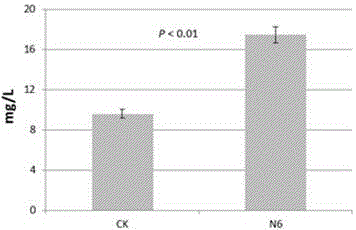Paenibacillus mucilaginosus N6 and application thereof
A technology of Paenibacillus and Bacillus, applied in Paenibacillus colioids N6 and its application fields, can solve the problems of low yield, prone to lodging, poor stress resistance, etc., achieve significant increment, promote growth and development, and promote coloring rate Effect
- Summary
- Abstract
- Description
- Claims
- Application Information
AI Technical Summary
Problems solved by technology
Method used
Image
Examples
Embodiment 1
[0024] Example 1: Cultivation of Paenibacillus colioids N6.
[0025] Silicate bacteria medium: sucrose 5g, Na2HPO4 2g, MgSO4 7H2O 0.5g, FeCl3 0.005g, CaCO3 0.1g, soil minerals * 1.0g, agar 15~20g, water 1000ml, pH 70~7.5
[0026] Soil minerals: remove organic residues from the soil, add 6N HCl to boil for half an hour, filter, rinse with distilled water until there is no reaction of chloride ions. Or use 1.0g of potassium feldspar powder.
[0027] The medium is sterilized, and when the temperature drops to about 60°C, add 1g of boiled soil minerals or potassium feldspar powder washed with hydrochloric acid, mix well, and pour onto a plate. Paenibacillus coli N6 can grow on silicate solid medium.
Embodiment 2
[0028] Embodiment 2: Determination of Paenibacillus colioids N6 liquid potassium decomposing ability
[0029] Liquid potassium solution test medium: sucrose 10.0g, Na 2 HPO 4 2.0g, MgSO 4 ·7H 2 O 0.5g, (NH 4 ) 2 SO 4 1.0g, NaCl 0.1g, CaCO 3 1.0g, yeast extract 0.5g, potassium feldspar powder 10.0g, water 1000mL, pH 7.2.
[0030] Grind potassium feldspar, pass through a 100-mesh sieve, wash with water to remove water-soluble potassium, and dry in the shade. 50 mL of the above-mentioned culture medium was divided into 250 mL Erlenmeyer flasks, 1.0 g of soil minerals (100 mesh) were added, sterilized at 121 °C for 30 min, and 2 colonies with a diameter close to 1 cm were inserted. The control was not inoculated, and the experiment was repeated 5 times. After shaking culture at 28°C for 5 days, the increase of available potassium was analyzed by flame photometer, and the results were as follows: figure 2 shown.
[0031] from figure 2 As a result, it can be seen that...
Embodiment 3
[0032] Example 3: Paenibacillus colioids N6 capsule staining
[0033] Materials: Paenibacillus coli N6, capsule staining solution, slide glass, pure methanol, black carbon ink, sterile water.
[0034] Steps: Put a drop of sterile water on the glass slide, take a little Paenibacillus colioids N6 cultured for 72 hours to make a suspension in water, take a drop of prepared black carbon ink and mix it with the bacteria suspension, and take another piece The glass slide is used as a pusher, after contacting the flat edge of one end of the pusher with the suspension at an angle of 30 degrees, the suspension is pushed forward to form a uniform and thin layer, and air-dried. Fix with pure methanol for 1 minute, add lycopene drop on the smear, wash away the residual methanol, and stain for 30 seconds, rinse with a thin stream of water, blot dry and check with oil microscope, the background is black, the capsule is colorless, and the cells are red ,like image 3 shown.
PUM
 Login to View More
Login to View More Abstract
Description
Claims
Application Information
 Login to View More
Login to View More - R&D
- Intellectual Property
- Life Sciences
- Materials
- Tech Scout
- Unparalleled Data Quality
- Higher Quality Content
- 60% Fewer Hallucinations
Browse by: Latest US Patents, China's latest patents, Technical Efficacy Thesaurus, Application Domain, Technology Topic, Popular Technical Reports.
© 2025 PatSnap. All rights reserved.Legal|Privacy policy|Modern Slavery Act Transparency Statement|Sitemap|About US| Contact US: help@patsnap.com



